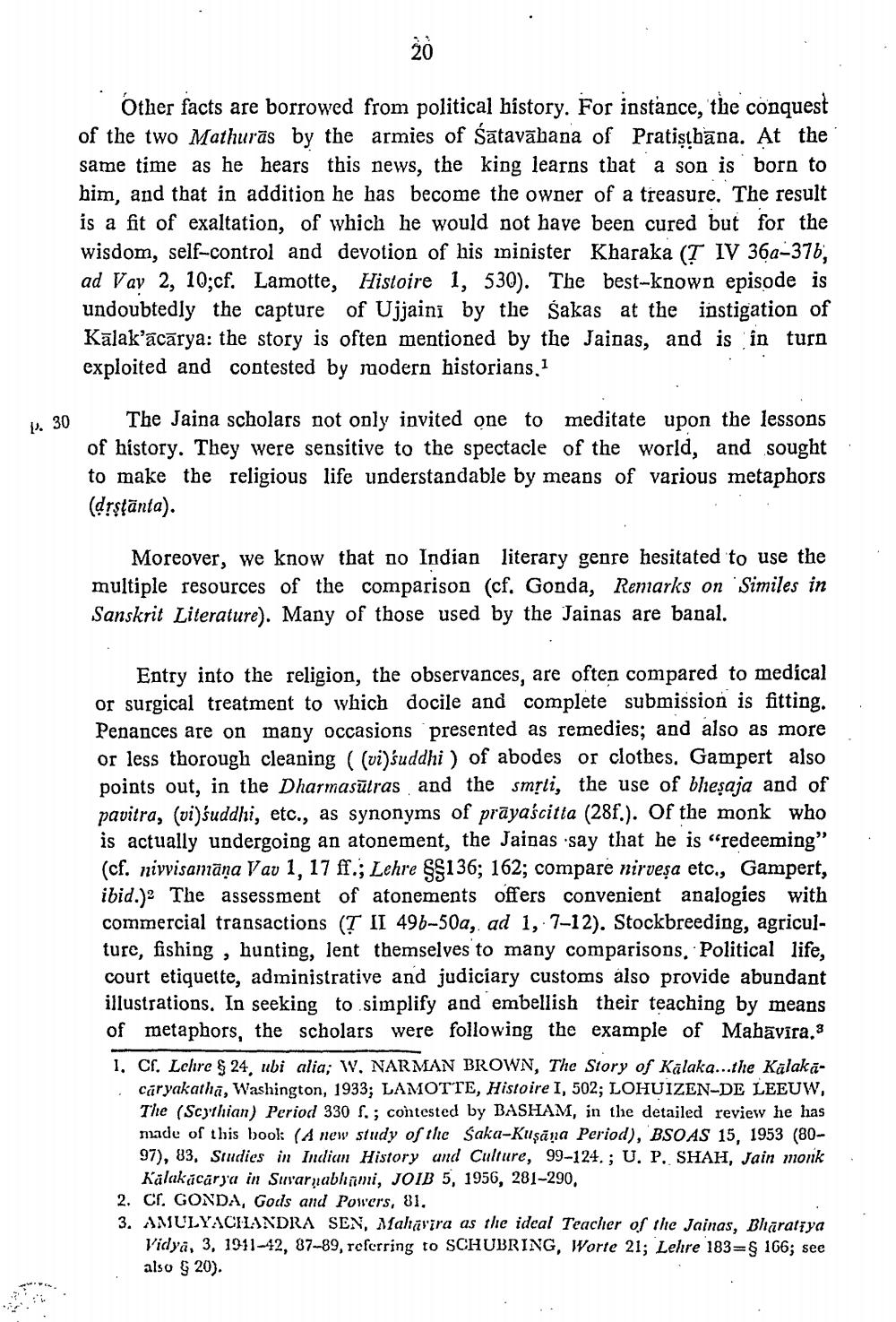________________
Other facts are borrowed from political history. For instance, the conquest of the two Mathurās by the armies of śātavāhana of Pratiștbāna. At the same time as he hears this news, the king learns that a son is born to him, and that in addition he has become the owner of a treasure. The result is a fit of exaltation, of which he would not have been cured but for the wisdom, self-control and devotion of his minister Kharaka (T IV 369-376, ad Vay 2, 10;cf. Lamotte, Histoire 1, 530). The best-known episode is undoubtedly the capture of Ujjaini by the Sakas at the instigation of Kālak’ācārya: the story is often mentioned by the Jainas, and is in turn exploited and contested by modern historians, 1
1. 30
The Jaina scholars not only invited one to meditate upon the lessons of history. They were sensitive to the spectacle of the world, and sought to make the religious life understandable by means of various metaphors (drsțānta).
Moreover, we know that no Indian literary genre hesitated to use the multiple resources of the comparison (cf. Gonda, Remarks on Similes in Sanskrit Literature). Many of those used by the Jainas are banal.
Entry into the religion, the observances, are often compared to medical or surgical treatment to which docile and complete submission is fitting. Penances are on many occasions presented as remedies; and also as more or less thorough cleaning ((vi)suddhi ) of abodes or clothes, Gampert also points out, in the Dharmasülras and the smrti, the use of bhiesaja and of pavitra, (vi)śuddhi, etc., as synonyms of prāyaścitta (28f.). Of the monk who is actually undergoing an atonement, the Jainas say that he is "redeeming" (cf. nivvisamāņa Vav 1, 17 ff.; Lehre S$136; 162; compare nirveşa etc., Gampert, ibid.): The assessment of atonements offers convenient analogies with commercial transactions (T II 496-50a, ad 1, 7–12). Stockbreeding, agriculture, fishing, hunting, lent themselves to many comparisons, Political life, court etiquette, administrative and judiciary customs also provide abundant illustrations. In seeking to simplify and embellish their teaching by means of metaphors, the scholars were following the example of Mabāvīra,3 1. Cf. Lclire & 24, ubi alia; W. NARMAN BROWN, The Story of Kalaka...the Kalakā
caryakatha, Washington, 1933; LAMOTTE, Histoire I, 502; LOHUIZEN-DE LEEUW, The (Scythian) Period 330 f.; contested by BASHAM, in the detailed review he has made of this book (A new study of the Saka-Kuşāna Period), BSOAS 15, 1953 (8097), 83. Studies in Indian History and Culture, 99-124, ; U. P. SHAH, Jain monk
Kalakucarya in Swarnabhimi, JOIB 5, 1956, 281-290, 2. Cr. GONDA, Gods and Powers, 81, 3. AMULYACHANDRA SEN, Mahavira as the ideal Teacher of the Jainas, Bharatiya
Vidya, 3, 1911-42, 87-89, referring to SCHUBRING, Worte 21; Lehre 183=$ 166; see also G 20).




